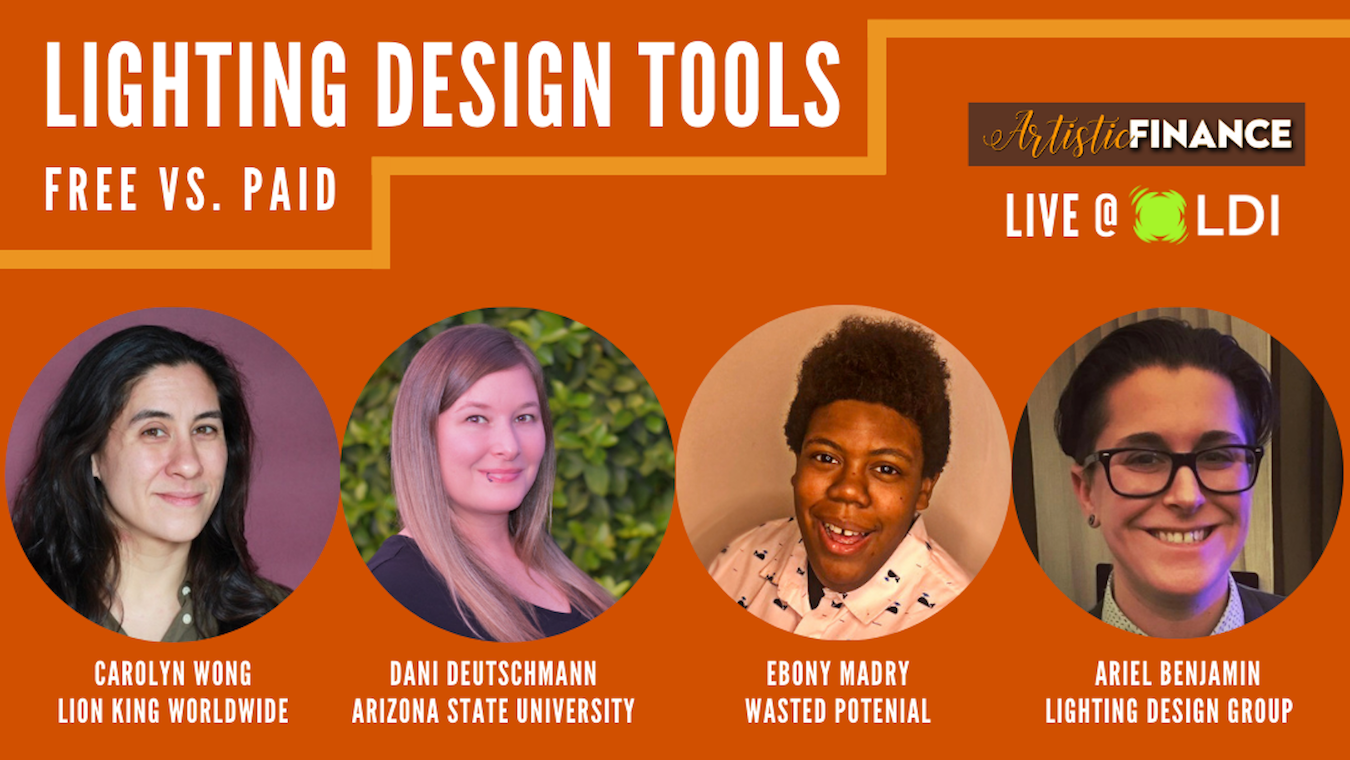
The Artistic Finance podcast relaunched this month and one of the first episodes is the live recording from LDI 2023. A panel of lighting designers from across theater, television, and live events came together to discuss the tools and software essential for their work. The conversation delved into the costs, considerations, and what software might become indispensable in the near future.
Artistic Finance will record another episode of Artistic Finance LIVE at LDI 2024 titled “Financial Independence For Creatives” featuring host Ethan Stiemel and LD Amy D. Lux.
Last year’s session focused on versatility of design tools, as the panelists who pointed out that skills and tools transfer between live events from broadcast television, theater, and concerts. Representing concert, music tours, and large scale events was Ebony Madry, a lighting designer and project manager with Wasted Potential. Representing broadcast television was Ariel Benjamin, a lighting designer with The Lighting Design Group and who is the lighting designer for The Tamron Hall Show. Broadway, touring, and sit-down musicals were represented by Carolyn Wong, who is the worldwide associate for The Lion King. And rounding out the panel, representing theater and academia from Arizona State University, was lighting supervisor Dani Deutschmann, and wearing a second hat, visiting professor Ethan Steimel.
The discussion kicked off with Filemaker, highlighted by Carolyn Wong as an essential tool for organizing complex lighting paperwork. Despite its initial learning curve, its database capabilities allow for it to hold a majority of The Lion King’s lighting paperwork. Ethan noted Filemaker is used for a lot of followspot tracking for musicals and advises anyone who encounters it on a project to dedicate time to learn the program as it will show up again and again.
Carolyn also mentioned Vor, which records video of a show with Eos light cues overlaid, being an indispensable tool for remounting Lion King over and over. It helps see cue placements and allows the designers to adjust timings and light tracking to the performer’s pace.
Ariel Benjamin brought attention to the Luma light meter, affirming that it remains a relevant and viable tool for lighting directors. With pocket-sized meters available from €299 to €500, it fills a niche between free phone apps and the pricier, but robust, light and color meters.
Ebony Madry provided insights with two key tools. Lightning Tapes / Autoplot as particularly useful for generating hang tapes. Those programs will print out receipt paper hang tapes to scale, after being aligned in the Vectorworks plot to locate the centerline. It is a favorite among electricians and detail-oriented lighting designers.
The conversation shifted to project management as Ebony introduced Discord as a way to have a central resource hub that everyone working on a project can join as needed. Dani Deutschmann recommended Asana as effective software for production electricians as they coordinate teams to finish tasks throughout the production process. With a free seat for up to 15 people, Dani has never found the need to utilize the paid version. Ebony mentioned she uses Monday for the same purpose and Ethan shared his brief experience with Trello, though not for lighting but rather for organizing project lists for Artistic Finance. All three of the programs have a free tier that is more than adequate for production needs.
Ebony highlighted Twinmotion, a program integrating with Vectorworks that she uses to add animated crowds to previz projects. The purpose being to provide renderings for an event to show producers and clinch the job for Ebony. Twinmotion is available for free to students, educational institutions, and companies with annual revenues under $1 million. This accessibility makes it a valuable resource for anyone who needs it.
Ethan shared his experience with Zoom, recently subscribing for $200 a year. With his return to freelancing and a busy interview schedule, having his own Zoom account has proven essential. Ebony also subscribes to her own seat of Zoom because she doesn’t like company branding for meetings that aren’t related to company business.
The discussion also touched on Capture, a visualization tool with a demo version accessible to all. Although the demo has limitations of a 90-minute session timeout and no save capability. But it remains useful for quick and sleek previz. A single universe purchase is less than $500, making it a reasonably priced program for anyone that incorporates it into their workflow on the regular. Similarly, Vision, the Vectorworks’ visualizer, was highlighted as an option for those integrated into the Vectorworks ecosystem. Vision offers four universes within the Spotlight subscription.
Throughout the episode, the panel’s insights highlighted the importance of staying up to date with industry tools and technologies. Which, it did not go unnoticed, is a major purpose of why people attend LDI. The panelists themselves learned about new software programs and techniques. Carolyn and Ethan both mentioned that they need to learn Capture as it can enhance design previz and note sessions, regardless of what aspect of the industry you are working in.
To watch the video on Youtube: Artistic Finance @LDI2023
To listen: Artistic Finance @LDI2023 podcast
